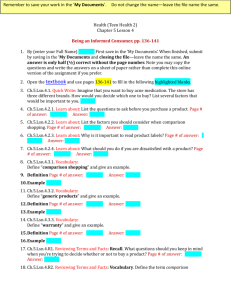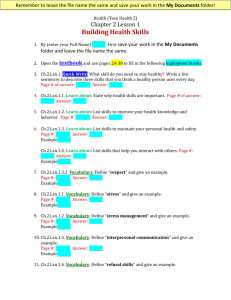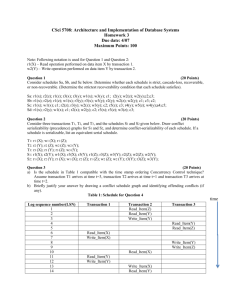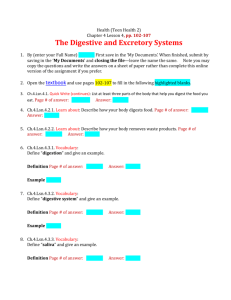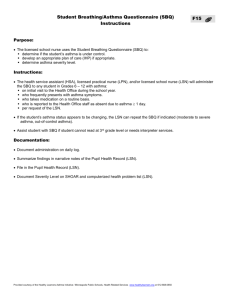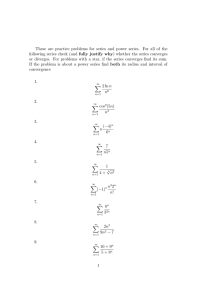Database System Principles More TP More on transaction processing
advertisement
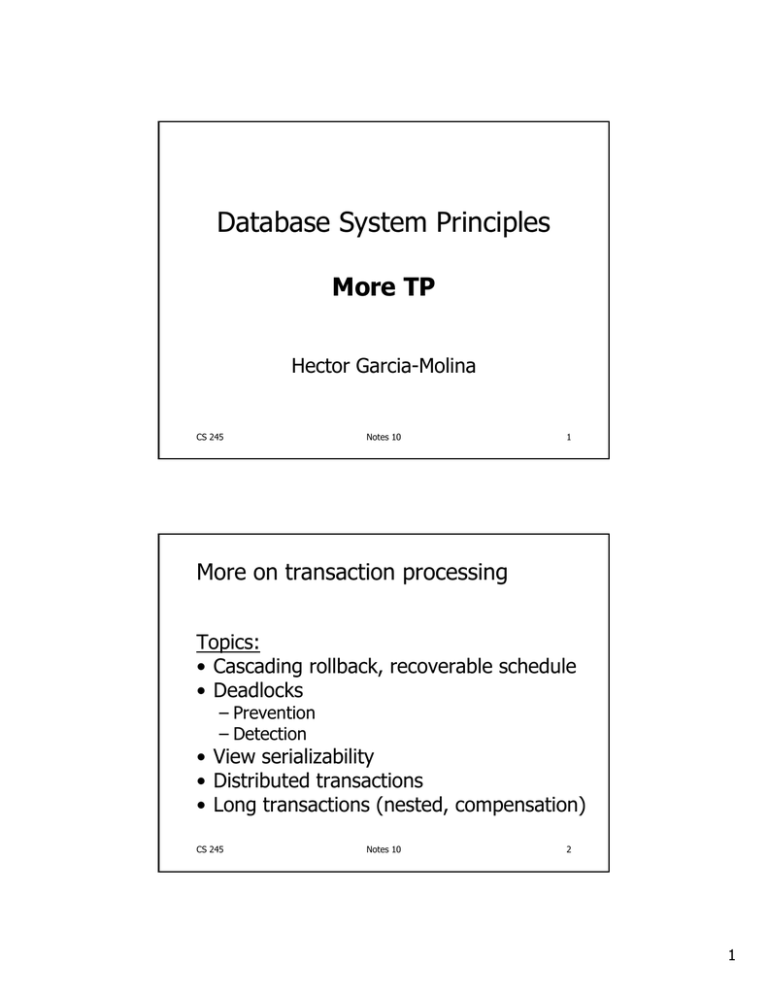
Database System Principles
More TP
Hector Garcia-Molina
CS 245
Notes 10
1
More on transaction processing
Topics:
• Cascading rollback, recoverable schedule
• Deadlocks
– Prevention
– Detection
• View serializability
• Distributed transactions
• Long transactions (nested, compensation)
CS 245
Notes 10
2
1
Tj
Ti
……
Wj(A)
… …
ri(A)
Commit Ti
Abort Tj
( Cascading rollback
CS 245
…
Example:
…
Concurrency control & recovery
(Bad!)
Notes 10
3
• Schedule is conflict serializable
Ti
• Tj
• But not recoverable
CS 245
Notes 10
4
2
• Need to make “final’ decision for each
transaction:
– commit decision - system guarantees
transaction will or has completed, no
matter what
– abort decision - system guarantees
transaction will or has been rolled back
(has no effect)
CS 245
Notes 10
5
To model this, two new actions:
• Ci - transaction Ti commits
• Ai - transaction Ti aborts
CS 245
Notes 10
6
3
Back to example:
Ti
...
...
Tj
ri(A)
...
...
Wj(A)
Ci ←
CS 245
can we commit
here?
Notes 10
7
Definition
Ti reads from Tj in S (Tj ⇒S Ti) if
(1) wj(A) <S ri(A)
(2) aj <S ri(A)
(< :
does not precede)
(3) If wj(A) <S wk(A) <S ri(A) then
ak <S ri(A)
CS 245
Notes 10
8
4
Definition
Schedule S is recoverable if
whenever Tj ⇒S Ti and j ≠ i and Ci ∈ S
then Cj <S Ci
CS 245
Notes 10
9
Note: in transactions, reads and writes
precede commit or abort
➳ If Ci ∈ Ti, then ri(A) < Ci
wi(A) < Ci
➳ If Ai ∈ Ti, then ri(A) < Ai
wi(A) < Ai
• Also, one of Ci, Ai per transaction
CS 245
Notes 10
10
5
How to achieve recoverable schedules?
CS 245
Notes 10
11
➳ With 2PL, hold write locks to
Tj
Ti
...
... ... ... ...
commit (strict 2PL)
...
Wj(A)
...
Cj
uj(A)
CS 245
ri(A)
Notes 10
12
6
➳ With validation, no change!
CS 245
Notes 10
13
• S is recoverable if each transaction
commits only after all transactions from
which it read have committed.
• S avoids cascading rollback if each
transaction may read only those values
written by committed transactions.
CS 245
Notes 10
14
7
• S is strict if each transaction may read
and write only items previously written
by committed transactions.
RC
ST
Avoids SERIAL
cascading rollback
ACR
CS 245
Notes 10
15
Where are serializable schedules?
RC
ST
Avoids SERIAL
cascading rollback
ACR
CS 245
Notes 10
16
8
Examples
• Recoverable:
– w1(A) w1(B) w2(A) r2(B) c1 c2
• Avoids Cascading Rollback:
– w1(A) w1(B) w2(A) c1 r2(B) c2
Assumes w2(A) is done
without reading
• Strict:
– w1(A) w1(B) c1 w2(A) r2(B) c2
CS 245
Notes 10
17
Deadlocks
• Detection
– Wait-for graph
• Prevention
– Resource ordering
– Timeout
– Wait-die
– Wound-wait
CS 245
Notes 10
18
9
Deadlock Detection
•
•
•
•
Build Wait-For graph
Use lock table structures
Build incrementally or periodically
When cycle found, rollback victim
T4
CS 245
T5
T2
T1
T6
T3
T7
Notes 10
19
Resource Ordering
• Order all elements A1, A2, …, An
• A transaction T can lock Ai after Aj only
if i > j
Problem : Ordered lock requests not
realistic in most cases
CS 245
Notes 10
20
10
Timeout
• If transaction waits more than L sec.,
roll it back!
• Simple scheme
• Hard to select L
CS 245
Notes 10
21
Wait-die
• Transactions given a timestamp when
they arrive …. ts(Ti)
• Ti can only wait for Tj if ts(Ti)< ts(Tj)
...else die
CS 245
Notes 10
22
11
Example:
T1
wait
(ts =10)
T2
wait?
wait
(ts =20)
T3
(ts =25)
CS 245
Notes 10
23
Second Example:
T1
requests A: wait for T2 or T3?
(ts =22)
T2
Note: ts between
20 and 25.
wait(A)
(ts =20)
T3
(ts =25)
CS 245
Notes 10
24
12
Second Example (continued):
One option: T1 waits just for T3, transaction holding lock.
But when T2 gets lock, T1 will have to die!
T1
(ts =22)
T2
wait(A)
wait(A)
(ts =20)
T3
(ts =25)
CS 245
Notes 10
25
Second Example (continued):
Another option: T1 only gets A lock after T2, T3 complete,
⇒
so T1 waits for both T2, T3
T1 dies right away!
T1
wait(A)
(ts =22)
T2
wait(A)
wait(A)
(ts =20)
T3
(ts =25)
CS 245
Notes 10
26
13
Second Example (continued):
Yet another option: T1 preempts T2, so T1 only waits for
T3; T2 then waits for T3 and T1...
⇒
T2 may starve?
T1
(ts =22)
wait(A)
T2
wait(A)
wait(A)
T3
(ts =25)
CS 245
(ts =20)
redundant arc
Notes 10
27
Wound-wait
• Transactions given a timestamp when
they arrive … ts(Ti)
• Ti wounds Tj if ts(Ti)< ts(Tj)
else Ti waits
“Wound”: Tj rolls back and gives lock to Ti
CS 245
Notes 10
28
14
Example:
T1
wait
(ts =25)
T2
wait
wait
(ts =20)
T3
(ts =10)
CS 245
Notes 10
29
Second Example:
T1
requests A: wait for T2 or T3?
(ts =15)
T2
Note: ts between
10 and 20.
wait(A)
(ts =20)
T3
(ts =10)
CS 245
Notes 10
30
15
Second Example (continued):
One option: T1 waits just for T3, transaction holding lock.
But when T2 gets lock, T1 waits for T2 and wounds T2.
T1
(ts =15)
T2
wait(A)
wait(A)
(ts =20)
T3
(ts =10)
CS 245
Notes 10
31
Second Example (continued):
Another option: T1 only gets A lock after T2, T3 complete,
⇒
so T1 waits for both T2, T3
T2 wounded right away!
T1
wait(A)
(ts =15)
T2
wait(A)
wait(A)
(ts =20)
T3
(ts =10)
CS 245
Notes 10
32
16
Second Example (continued):
Yet another option: T1 preempts T2, so T1 only waits for
T3; T2 then waits for T3 and T1...
⇒
T2 is spared!
T1
(ts =15)
wait(A)
T2
wait(A)
wait(A)
(ts =20)
T3
(ts =10)
CS 245
Notes 10
33
User/Program commands
Lots of variations, but in general
• Begin_work
• Commit_work
• Abort_work
CS 245
Notes 10
34
17
Nested transactions
...
User program:
... ...
Begin_work;
If results_ok, then commit work
else abort_work
CS 245
Notes 10
35
Nested transactions
...
User program:
Begin_work;
...
Begin_work;
...
If results_ok, then commit work
else {abort_work; try something else…}
If results_ok, then commit work
else abort_work
CS 245
Notes 10
36
18
Parallel Nested Transactions
begin-work
...
T1:
...
parallel:
T11: begin_work
commit_work
T1
T1
T11
T12
...
...
T12: begin_work
commit_work
commit_work
CS 245
Notes 10
37
Locking
Locking
What are we really locking?
CS 245
Notes 10
38
19
Ti
...
Example:
...
Read record r1
do record
locking
...
Read record r1
...
Modify record r3
CS 245
Notes 10
39
But underneath:
If we lock all
record id
R1
R2
data involved in read
of R1, we may prevent
an update to R2
(which may require
reorganization within
R3
block)
Disk
pages
CS 245
Notes 10
40
20
Solution: view DB at two levels
Top level: record actions
record locks
undo/redo actions — logical
e.g., Insert record(X,Y,Z)
Redo: insert(X,Y,Z)
Undo: delete
CS 245
Notes 10
41
Low level: deal with physical details
latch page during action
(release at end of action)
CS 245
Notes 10
42
21
Note: undo does not return physical DB
to original state; only same logical state
e.g.,
Insert R3
R1
R2
CS 245
Undo
R1
R2
(delete R3)
R1
R2
R3
Notes 10
43
Logging Logical Actions
• Logical action typically span one block
(physiological actions)
• Undo/redo log entry specifies
undo/redo logical action
• Challenge: making actions idempotent
• Example (bad): redo insert ⇒
key inserted multiple times!
CS 245
Notes 10
44
22
Solution: Add Log Sequence Number
sem
lsn=25
...
3, v1
Log record:
•LSN=26
•OP=insert(5,v2)
into P
• ...
sem
lsn=26
...
3, v1
5, v2
CS 245
Notes 10
45
Still Have a Problem!
Make log entry
for undo
lsn=27
lsn=24
...
lsn=25
3, v1
4, v2
lsn=26
3, v1
T1
Del 4
CS 245
...
...
lsn=??
3, v1
5, v3
4, v2
3, v1
5, v3
T2
Ins 5
Notes 10
...
undo
Del 4
46
23
Compensation Log Records
• Log record to indicate undo (not redo)
action performed
• Note: Compensation may not return
page to exactly the initial state
CS 245
Notes 10
47
At Recovery: Example
Log:
...
CS 245
lsn=21
lsn=27
T1
T1
a1 ... a2
p1
p2
...
Notes 10
lsn=35
T1
a2-1 ...
p2
48
24
What to do with p2 (during T1 rollback)?
• If lsn(p2)<27 then ... ?
• If 27 ≤ lsn(p2) < 35 then ... ?
• If lsn(p2) ≥ 35 then ... ?
Note: lsn(p2) is lsn of p copy on disk
CS 245
Notes 10
49
Recovery Strategy
[1] Reconstruct state at time of crash
– Find latest valid checkpoint, Ck, and let ac
be its set of active transactions
– Scan log from Ck to end:
• For each log entry [lsn, page] do:
if lsn(page) < lsn then redo action
• If log entry is start or commit, update ac
CS 245
Notes 10
50
25
Recovery Strategy
[2] Abort uncommitted transactions
– Set ac contains transactions to abort
– Scan log from end to Ck :
• For each log entry (not undo) of an ac transaction,
undo action (making log entry)
– For ac transactions not fully aborted,
read their log entries older than Ck and
undo their actions
CS 245
Notes 10
51
Example: What To Do After Crash
Log:
chk
pt
...
CS 245
lsn=21
T1
a1
p1
lsn=27
T1
... a2
p2
lsn=29
T1
a3
... p3
Notes 10
...
lsn=31
T1
a3-1
p3
...
lsn=35
T1
a2-1
p2
...
52
26
During Undo: Skip Undo’s
pointer to forward action
Log:
chk
pt
...
lsn=21
T1
a1
p1
lsn=27
T1
... a2
p2
lsn=29
T1
a3
... p3
...
lsn=31
T1
a3-1
p3
...
lsn=35
T1
a2-1
p2
...
pointer to previous T1 action
CS 245
Notes 10
53
Related idea: Sagas
• Long running activity: T1, T2, ... Tn
• Each step/trasnaction Ti has a
compensating transaction Ti-1
• Semantic atomicity: execute one of
...
– T1, T2, ... Tn
– T1, T2, ... Tn-1 T-1n-1, T-1n-2, ... T-11
– T1, T2, ... Tn-2 T-1n-2, T-1n-3, ... T-11
– T1, T-11
– nothing
CS 245
Notes 10
54
27
Summary
• Cascading rollback
Recoverable schedule
• Deadlock
– Prevention
– Detectoin
• Nested transactions
• Multi-level view
CS 245
Notes 10
55
28
